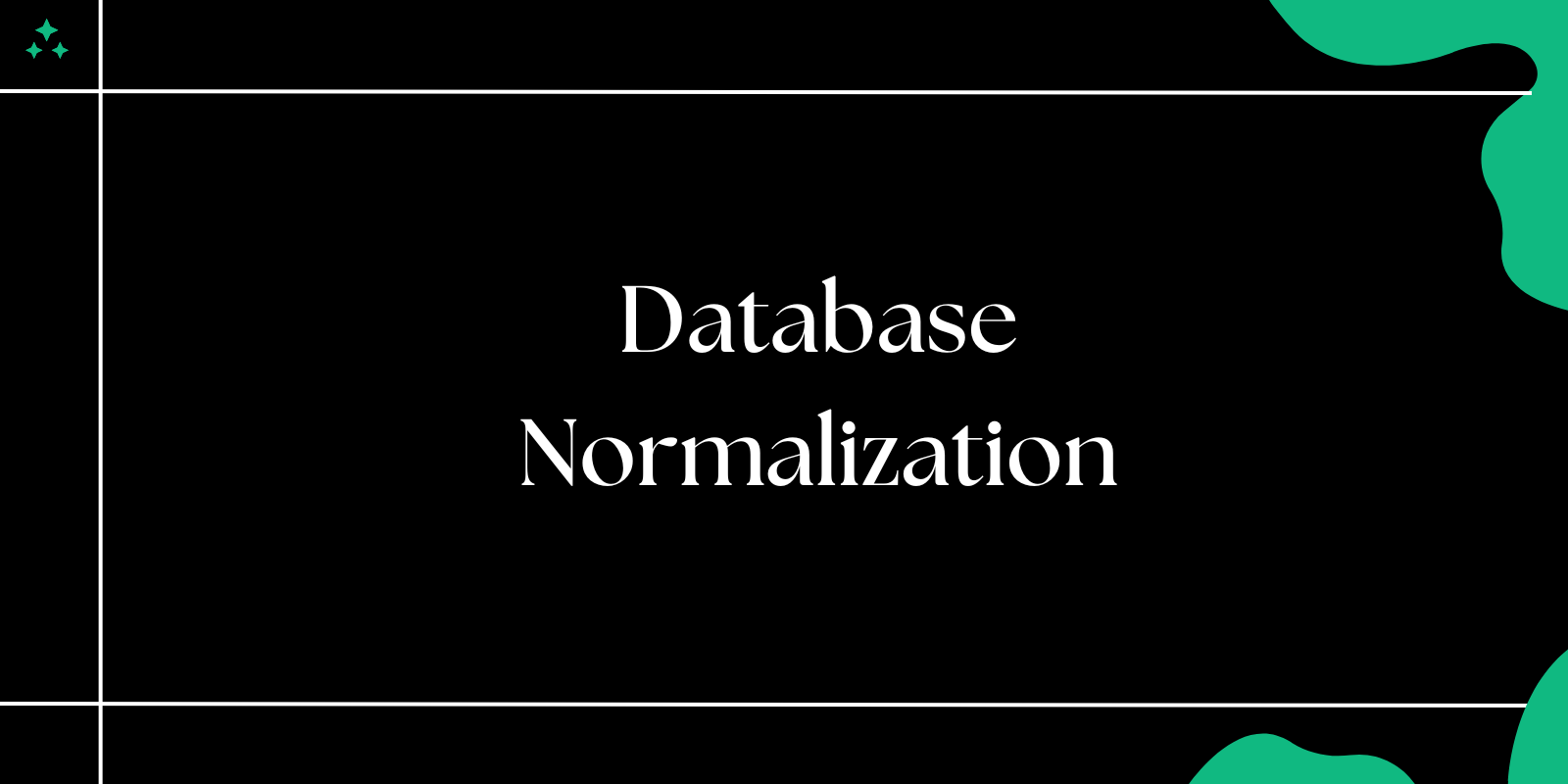In the world of relational databases, normalization plays a critical role in ensuring efficiency, consistency, and integrity of data. Despite its importance, many developers overlook this process, leading to poorly designed databases that are difficult to maintain and prone to errors. This blog will demystify database normalization, explain its benefits, and show you how to implement it effectively.
What Is Database Normalization?
Database normalization is the process of structuring a database to reduce redundancy and improve data integrity. It involves organizing data into tables and defining relationships between them, following a series of rules called normal forms (NFs).
Key Goals of Normalization:
- Minimize data redundancy: Eliminate duplicate data across the database.
- Ensure data integrity: Maintain consistency and accuracy of data.
- Simplify maintenance: Facilitate easier updates and scalability.
Why Does Database Normalization Matter?
1. Eliminates Data Redundancy
By dividing data into related tables, normalization prevents the same data from being stored in multiple places, reducing storage costs and redundancy.
2. Enhances Data Integrity
Normalization ensures that data is stored logically and consistently, reducing the risk of anomalies during insert, update, or delete operations.
3. Improves Query Performance
A well-structured database allows for faster and more efficient queries, especially when dealing with large datasets.
4. Simplifies Maintenance
Normalized databases are easier to modify, extend, and maintain as the application evolves.
Normal Forms: The Building Blocks of Normalization
Database normalization is achieved by adhering to normal forms. Here’s a breakdown of the first three, which are the most commonly used:
1. First Normal Form (1NF)
Goal: Ensure all columns contain atomic values, and there are no repeating groups or arrays.
Example Scenario: Imagine a table storing student information, including courses they are enrolled in:
Unnormalized Table:
| StudentID | StudentName | Courses |
|---|---|---|
| 101 | Alice | Math, Science |
| 102 | Bob | History, English |
Problems:
- The
Coursescolumn contains multiple values (not atomic). - It's hard to query for specific courses.
1NF Table: To bring this table into 1NF:
- Split multi-valued columns into separate rows.
| StudentID | StudentName | Course |
|---|---|---|
| 101 | Alice | Math |
| 101 | Alice | Science |
| 102 | Bob | History |
| 102 | Bob | English |
Now:
- Each column contains atomic (indivisible) values.
- No repeating groups exist.
2. Second Normal Form (2NF):
Goal: Ensure the table is in 1NF, and every non-key column is fully dependent on the primary key.
Example Scenario: Using the 1NF table above, let's assume:
- The
StudentIDandCoursetogether form a composite primary key. - You want to add instructor details for courses.
1NF Table:
| StudentID | StudentName | Course | Instructor |
|---|---|---|---|
| 101 | Alice | Math | Dr. Smith |
| 101 | Alice | Science | Dr. Brown |
| 102 | Bob | History | Dr. White |
| 102 | Bob | English | Dr. Taylor |
Problems:
Instructoris only dependent onCourse, not on the composite key (StudentID,Course).- This violates 2NF.
2NF Tables:
After analyzing the dependencies, the tables are separated into three distinct tables to remove partial dependency:
- Students Table:
This table stores student-specific information, withStudentIDas the primary key.
| StudentID | StudentName |
|---|---|
| 101 | Alice |
| 102 | Bob |
- Courses Table:
This table contains course-related data, withCourseas the primary key, ensuring that each course has a single instructor.
| Course | Instructor |
|---|---|
| Math | Dr. Smith |
| Science | Dr. Brown |
| History | Dr. White |
| English | Dr. Taylor |
- Enrollments Table:
This table establishes a relationship between students and courses, with a composite primary key (StudentID,Course).
| StudentID | Course |
|---|---|
| 101 | Math |
| 101 | Science |
| 102 | History |
| 102 | English |
Explanation:
- Students Table: Contains student data and is independent of course-related information, removing any redundant data.
- Courses Table: Contains information about each course and the instructor teaching it.
- Enrollments Table: Creates a relationship between students and the courses they are enrolled in, using the composite key (
StudentID,Course).
This structure ensures that all non-key columns depend entirely on the primary key of each table, adhering to 2NF principles and removing partial dependencies.
Now:
- Every non-key column depends entirely on the primary key.
- Redundant data (e.g., instructor details) is eliminated.
3. Third Normal Form (3NF):
Goal: Ensure the table is in 2NF, and there are no transitive dependencies (non-key columns must depend only on the primary key).
Example Scenario: Suppose we expand the Courses table from 2NF to include the department for each instructor:
2NF Courses Table:
| Course | Instructor | Department |
|---|---|---|
| Math | Dr. Smith | Mathematics |
| Science | Dr. Brown | Science |
| History | Dr. White | Humanities |
| English | Dr. Taylor | Humanities |
Problems:
Departmentdepends onInstructor, not directly onCourse.- This violates 3NF.
To eliminate transitive dependencies, we split the data into two separate tables, ensuring that every non-key column depends directly on the primary key.
- Courses Table:
This table keeps a direct relationship between courses and their instructors.
| Course | Instructor |
|---|---|
| Math | Dr. Smith |
| Science | Dr. Brown |
| History | Dr. White |
| English | Dr. Taylor |
- Instructors Table:
This table associates instructors with their respective departments, ensuring thatDepartmentdepends solely on the primary key (Instructor).
| Instructor | Department |
|---|---|
| Dr. Smith | Mathematics |
| Dr. Brown | Science |
| Dr. White | Humanities |
| Dr. Taylor | Humanities |
Detailed Explanation:
- Courses Table:
TheInstructorcolumn is now directly linked toCourse, removing unnecessary dependencies and ensuring a clean relationship. - Instructors Table:
TheDepartmentcolumn is now exclusively tied to theInstructor, ensuring there are no indirect dependencies.
This separation achieves the goal of 3NF by:
- Eliminating redundancy (e.g., duplicating department names across courses).
- Simplifying updates (e.g., changing an instructor’s department only requires an update in the
Instructorstable). - Improving data integrity and scalability.
Now:
Departmentis directly associated withInstructor.CoursesandInstructorstables maintain clean relationships.
Advantages of Normalization
- Reduced Storage Costs: By eliminating redundant data, storage requirements decrease.
- Increased Consistency: Changes to data need to be made in only one place.
- Simplified Relationships: Clearly defined table relationships improve clarity and ease of use.
- Scalability: Easier to scale a normalized database to accommodate growth.
When to Normalize Your Database
While normalization offers numerous advantages, it’s not always the best solution. Over-normalization can lead to complex queries and performance bottlenecks. Consider normalization when:
- You need to ensure high data integrity.
- Storage efficiency is a priority.
- You’re designing a database for long-term scalability.
When not to normalize? If your application heavily relies on reads rather than writes, some degree of denormalization may improve performance.
Best Practices for Database Normalization
- Analyze Your Data Requirements: Understand the nature of your data and its relationships before normalizing.
- Follow the Normal Forms Incrementally: Apply normalization step-by-step, starting with 1NF and progressing as needed.
- Test for Query Performance: After normalization, test queries to ensure they perform efficiently.
- Balance Normalization with Denormalization: For read-heavy applications, consider partial denormalization for critical queries.
Conclusion
Database normalization is a fundamental process in relational database design. By reducing redundancy, improving data integrity, and simplifying maintenance, normalization ensures your database performs efficiently and is easier to manage. However, achieving the right balance between normalization and denormalization is key to optimizing performance.
Whether you're designing a new database or optimizing an existing one, understanding normalization is an essential skill for any developer.



